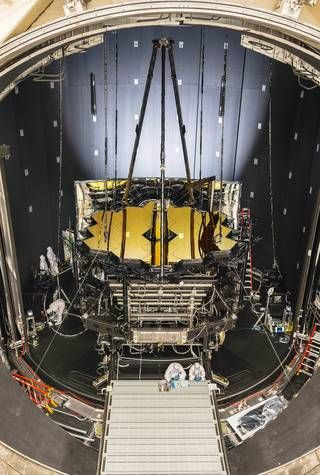NASA's James Webb Space Telescope’s New Laser-Focused Sight Explained

NASA’s James Webb Space Telescope (JWST) was scheduled to be launched in October of 2018 but now is planning to launch between March and June 2019 from French Guiana, following a schedule assessment of the remaining integration and test activities.
The telescope is being designed by NASA as its flagship space viewing lens. It will focus on stars and galaxies approximately 13.5 billion light-years away. But the problem with a telescope capable of such distant focus points is that its sight needs to be adjusted to focus on different objects. Just like your eyes, the lens on the telescope needs to be adjusted after launch to get a clear image of targets.
To counter this focus problem, NASA is will look to correct its aperture and focal length when it reaches Earth’s second Lagrange point (L2). This point is one million miles away from the Earth. According to a report released by NASA on Oct. 26, "when the telescope reaches the L2 it will use near-infrared camera (NIRCam) instrument to help align its primary mirror segments about 40 days after launch, once they have unfolded from their unaligned stowed position and cooled to their operating temperatures."
The Webb telescope has primary mirror segments that focus the light from a distant object to obtain a clear, vertical image. The positioning of Webb’s primary mirror segments will not be trained at the target perfectly. The angle of the mirrors will need to be very precise in order to focus on objects that are billions of light years away and are just a pin-point source of light.
NASA has countered this with the help of a process called wavefront sensing and control, which aligns the mirrors to degrees as small as tens of nanometers. The primary mirrors can be moved to a degree that is 1/10,000 times the diameter of a human hair. This nanoscale change will help engineers accurately align the sequence of mirrors to focus on one distant object. According to the report, "during this process, a wavefront sensor (NIRCam in this case) measures any imperfections in the alignment of the mirror segments that prevent them from acting like a single, 6.5-meter mirror." The same steps an eye surgeon takes while performing wavefront-guided laser vision correction surgery are used here. A surgeon maps the inconsistencies in the cornea and this map is fed into a laser which in-turn reshapes and resurfaces the cornea according to given measurements. This procedure used by ophthalmologists was seamlessly integrated into the mirror system with a few tweaks.
The NIRCam will be used to take test images of objects in space to determine how much they need to adjust each of the telescope’s 18 primary mirror segments. According to the report, the wavefront sensing and control process is broken into two parts — coarse phasing and fine phasing.
During the coarse phasing, engineers use the test images to find any large offsets in the focusing of the image. "NIRCam has a special filter wheel that can select, or filter, specific optical elements that are used during the coarse phasing process. While Webb looks at the bright star, grisms in the filter wheel will spread the white light of the star out on a detector. Grisms, also called grating prisms, are used to separate light of different wavelengths. To an observer, these different wavelengths appear as parallel line segments on a detector," said the report.
According to Lee Feinberg, telescope element manager for the Webb telescope at NASA’s Goddard Space Flight Center in Greenbelt, Maryland: "the light from each segment will interfere with adjacent segments, and if the segments are not aligned to better than a wavelength of light, that interference shows up like barber pole patterns. The analysis of the barber pole patterns tells us how to move the mirrors."
During the fine phasing, the telescope will be focused again on a bright object in space. Then, they will use NIRCam to take 18 out-of-focus images of that star — one from each mirror segment. The overall deviation in the focus is calculated for each mirror individually. The images are passed through computer algorithms "to determine the overall shape of the primary mirror from those individual images, and to determine how they must move the mirrors to align them. These algorithms were previously tested and verified on a 1/6th scale model of Webb’s optics, and the real telescope experienced this process inside the cryogenic, airless environment of Chamber A at NASA’s Johnson Space Center in Houston. Engineers will go through multiple fine-phasing sessions until those 18 separate, out-of-focus images become a single, clear image," said the report.
The entire alignment process is expected to take several months, and once Webb begins making observations, its mirrors will need to be checked every few days to ensure they are still aligned — just as someone who underwent laser vision correction surgery will schedule regular eye doctor visits to make sure their vision is not degrading.
© Copyright IBTimes 2024. All rights reserved.





















